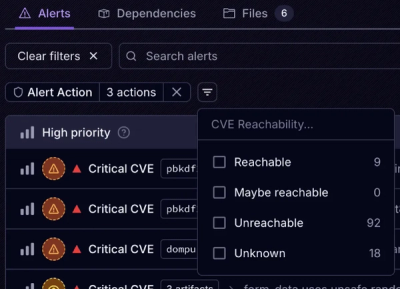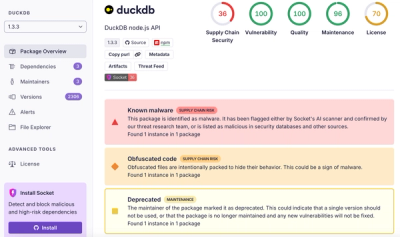
Product
Introducing Tier 1 Reachability: Precision CVE Triage for Enterprise Teams
Socket’s new Tier 1 Reachability filters out up to 80% of irrelevant CVEs, so security teams can focus on the vulnerabilities that matter.
gradient-gl
Advanced tools
Tiny WebGL library for procedural gradient animations. Deterministic. Seed-driven.

Tiny WebGL library for
Procedural Gradient Animations
Deterministic - Seed-driven
SeedScript
<script type="module" src="https://unpkg.com/gradient-gl?seed=a2.eba9"></script>
npm install gradient-gl
import gradientGL from 'gradient-gl'
// Mounts to <body>
gradientGL('a2.eba9')
// Mounts inside #app
gradientGL('a2.eba9', '#app')
// Access shader program if needed
const program = await gradientGL('a2.eba9')
<canvas> in <body><canvas> inside it<canvas>: uses it directly, no styles or DOM changesStyles are overridable.
export default {
build: {
target: 'esnext',
},
}
<script type="module">
import gradientGL from 'https://unpkg.com/gradient-gl'
gradientGL('a2.eba9')
</script>
<script type="module">
import gradientGL from 'https://esm.sh/gradient-gl'
gradientGL('a2.eba9')
</script>
<!-- Latest with default mounting point -->
<script type="module" src="https://unpkg.com/gradient-gl?seed=a2.eba9"></script>
<!-- optionally pin to a version @x.x.x -->
<script type="module" src="https://unpkg.com/gradient-gl@1.4.1?seed=a2.eba9"></script>
<!-- optionally set the mount selector -->
<!-- mount inside the <main> tag -->
<script type="module" src="https://unpkg.com/gradient-gl?seed=a2.eba9&selector=main"></script>
<!-- mount inside the .wrapper>content -->
<!-- note: any valid css selector can be used -->
<script type="module" src="https://unpkg.com/gradient-gl?seed=a2.eba9&selector=.wrapper>.content"></script>
<!-- mount inside the #app -->
<!-- note hash needs to be escaped as %23 -->
<!-- #app → %23app -->
<script type="module" src="https://unpkg.com/gradient-gl?seed=a2.eba9&selector=%23app"></script>
{shader}.{speed}{hue}{sat}{light}
[a-z][0-9] (e.g., a2)[0-9a-f] (hex values)Explore and generate seeds in the playground
Animated Gradient Background Techniques
(Slowest → Fastest)
SVG – CPU-only, DOM-heavy, poor scaling, high memory usageCanvas 2D – CPU-only, main-thread load, imperative updatesCSS – GPU-composited, limited complexity, best for staticWebGL – GPU-accelerated, shader-driven, optimal balanceWebGPU – GPU-native, most powerful, limited browser support[!NOTE] While WebGPU is technically the fastest, WebGL remains the best choice for animated gradients due to its maturity, broad support, and optimal performance/complexity ratio.
TODO: Interactive benchmark app
FAQs
Tiny WebGL library for procedural gradient animations. Deterministic. Seed-driven.
The npm package gradient-gl receives a total of 29 weekly downloads. As such, gradient-gl popularity was classified as not popular.
We found that gradient-gl demonstrated a healthy version release cadence and project activity because the last version was released less than a year ago. It has 1 open source maintainer collaborating on the project.
Did you know?

Socket for GitHub automatically highlights issues in each pull request and monitors the health of all your open source dependencies. Discover the contents of your packages and block harmful activity before you install or update your dependencies.

Product
Socket’s new Tier 1 Reachability filters out up to 80% of irrelevant CVEs, so security teams can focus on the vulnerabilities that matter.

Research
/Security News
Ongoing npm supply chain attack spreads to DuckDB: multiple packages compromised with the same wallet-drainer malware.

Security News
The MCP Steering Committee has launched the official MCP Registry in preview, a central hub for discovering and publishing MCP servers.